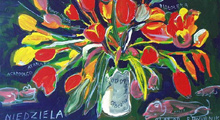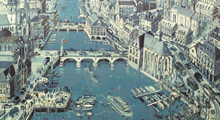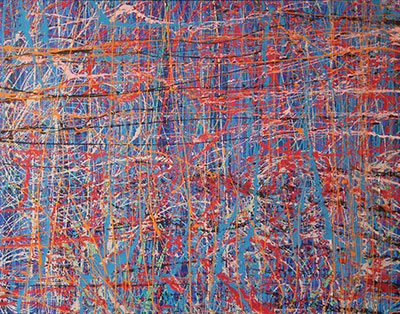Artistic order
Edward Dwurnik, one of the most prominent Polish painters is famous for his love of cleaning. While he washes his good paintings, those he doesn’t like end up in his dustbin, cut into small pieces. He washes his suits in the washing machine and cleans his fridge so fiercely it’s completely empty when he finishes with it. He records TV films only to remove commercial blocks and watch them again without distraction.
What is best for washing a painting?
Water and grey soap. I usually sponge my paintings. The large ones get vacuumed, too. I have an enormous collection of my paintings and, no matter how much time I spend cleaning them, they still get dusty all the time. And when there is an exhibition coming, I can’t display paintings covered by dust.
Rumour has it that, apart from washing, you also destroy some of your paintings. Is it like a process of weeding out?
I usually destroy paintings because I have got bored with them, I have too many or do not like them. I just don’t want them to fall into the wrong hands. When I was still at the Art Academy, some people used to sell the paintings I had thrown in the litter bin. The process of destruction has been documented and the photos showing me cutting my paintings are available in my exhibition catalogue in the ‘Zachęta’ National Gallery of Art. At first, I used to burn the paintings in the fireplace at home, but my neighbours pointed out that – with all that smoke – it wasn’t really an environmentally friendly solution. So nowadays this is what I do: if the stretcher (a wooden frame with wedged canvas) is still in a good condition, I cut the painting out with a special little knife and then scissor it into small pieces. This way I can use the stretcher later for another painting. I have reached such a level of proficiency in cutting paintings that the CIA could hire me as a document shredder.
Do you happen to suffer from sudden fits of cleaning fever?
Very much so! It’s thorough cleaning time then! Once I remember cleaning my fridge. When I finished, it looked brand new. I threw away literally everything that was there and brushed the inside. Ela has never forgiven me. She kept her nail polish there and claims I threw away 12 bottles. I also remember one time when, in a cleaning fit, I loaded my car with Russian art albums and exhibition catalogues with photos of my paintings and took it all to ‘Zachęta’. The ladies from their library were overjoyed and so was I. When I get rid of books, it’s always massive. I stand next to a bookshelf and put them in a cardboard box without even looking at titles.
Have you ever regretted throwing something away?
Well, yes. I do regret getting rid of my vinyl records and several years' issues of Film magazine, found somewhere by my daughter Pola. And I very much wish I hadn’t thrown away a year’s issues of Twórczość i poezja magazine.
How about clothes? Any regrets?
No, not really. Even if I throw them away, I don’t pay too much attention to that. Since my clothes often get blotched with paint, my wardrobe needs regular inspection. Sometimes when I dress up for an official meeting in an embassy or somewhere and have to wait for Ela to get ready, I grab a brush and paint something e.g. last touch-ups to a painting. When we are leaving home, my jacket is all covered in paint. Still, I do feel bad about the clothes I wasted while doing my laundry. I have washed lots of woollen suits in the washing machine. They were all made by a splendid Warsaw tailor – Zaremba. One cashmere jacket shrank so badly I had to throw it away. The suits survived, but now they look like the ones you can get in that avant-garde store - Comme des Garcons. They shrank and felted, but still have the style. Ela and my cousin have been wearing them now. As for shoes I must always have the same number of them. Whenever I buy a new pair, I have to throw an old one away. I do it abroad, in Paris or New York. I go there wearing these indestructible Polish shoes by Kielman, buy a new pair and leave the Kilemans on the street. I never put them in litter bins – it’s not done to throw such shoes away.
Is it true you clean the interior of your car yourself?
Well, a car is a different story. I can’t stand the mess people have in their vehicles! Do they forget why they keep a dust cloth inside? What do they need all those cushions, pillows, seat covers or wooden beads cushions for? If I could, I would burn such cars. Mine are always perfectly clean inside. I always vacuum them myself at a gasoline station and, once a year, I have the windows cleaned from the inside. Also, nothing ever gets spilt since I keep food in plastic containers and shopping in tight baskets in the boot.
Do you have your favourite cleaning agent for home?
I love ‘Kret’! It’s a drain cleaner for clearing clogged drains. At home I always have five containers of ‘Kret' standing next to each washbasin, bath tub and drain.
Granulated or liquid?
Liquid only. The granulated one accumulates in bends and fittings, which clogs drains even more. The liquid form of ‘Kret’ is the perfect solution. Since I often wash paint off my hands and brushes, clogged drains are my obsession. I always have that feeling the paint sediments in the pipes.
Your obsession with a clean and neat interior is said to make it impossible for you to stay in a clattered flat…
I can stay no longer than one hour in a messy flat, especially when it’s full of useless and unnecessary trinkets. In the past I remember suffering in doctors’ or dentists’ houses. They would buy and bring miscellaneous souvenirs – papyrus, little bells or small chests – from their package holidays abroad. It was a nightmare! I believe in a crystal clear and sterile interior with all equipment over the floor, i.e. furniture should have legs or be suspended. I loathe dark nooks where dust gathers.
So, you don’t have a shelf with travel souvenirs?
I do, but there are things from Guggenheim Museum or New York’s MoMA (the Museum of Modern Art) on that shelf, so it’s functional art.
If you see someone’s apartment is a mess, do you feel the urge to tidy it up?
Not in the case of regular, everyday mess. In Tarantino’s Pulp Fiction there is a guy, “an absolute cleaner”, whose specialty is to clean spots where Mafia goons executed someone. You know what that kind of place normally looks like. Total mess. So this guy comes and cleans it to such an extent there is not a single trace that something bad happened there. No blood, no bullet holes, not a thing. When the police arrive at the crime scene, there is no crime scene, it's pristine clean. I could be that guy.
This obsession with cleanness can also be seen in your paintings. The famous cities you paint from a bird’s eye view are perfect, ideal metropolises – no redundant elements.
If I painted a city the way it really looks like from up there, there would be so much chaos that no one would enjoy seeing that. So I must remove all unnecessary items – litter bins, cafe outdoor umbrellas, cars and people. I also change spatial proportions. If there are hills, I flatten them, because my cities are to be as flat as on the map.
So, elimination is the most vital part of your work?
As with any kind of artistic activity. A film director makes a movie with scissors, not with a camera, because the final product is what’s left after cutting the tape, not everything that’s been filmed. The same with a painter. The most important decision you make in this job is what to get rid of, what to cut out, what to give up on. And it’s no mean feat. Bad artists are those who cannot say ‘goodbye’ to some of their ideas, who are afraid to spoil their work of art, or who are so much in love with themselves that they uncritically accept everything they have created. That’s a common problem among young artists. During different meetings I often tell them they need to learn how to keep their painting in order. I advise them to look attentively for things to get rid of, and paint them over.
Don’t you think that cleanness and neatness may spoil your artistic image. Usually a real artist is expected to be a drop-out, or a rejected madman like Van Gogh, who cares neither about his surroundings nor his appearance. An artist who is a clean freak doesn’t inspire trust.
There is a myth like that, but I have always been very neat and tidy. My mum was an embroiderer, while my sisters used to crochet. The whole house was cluttered with tablemats, tapestries and little cushions. I utterly hated that and my studio upstairs was always kept in perfect order and equipped with the few things I really needed – some dishes and containers for still life arrangement.
Later when I became a student of the Art Academy I was truly amazed at the mess in which my teachers lived and worked. I remember a visit I paid to Professor Leon Michalski, who had a living room full of bottles. For twenty years he hadn’t thrown away a single bottle. Instead, he had been putting them on the floor. But the same thing happens abroad. When great painters such as Francis Bacon or Bernard Buffet, who were my masters, died and their ateliers were opened, they were in the state of such complete mess, it was almost impossible to enter the room and take the paintings out.
Cleanness by Dwurnik is very expansive, though. You tend to impose it upon others. After all, it’s your idea to paint over other artists’ paintings. Quite a hostile invasion of someone else’s territory, isn’t it?
I have painted my abstractions over paintings by Vlastimil Hoffman, Stefan Śledziewski and Wilhelm Sasnal. I do it because a finished painting is an ideal ground, since it’s got the light and energy which I would never be able to give it myself. And I would call it a creative act rather than a hostile invasion. Although I do agree it’s a form of provocation. I also think there are too many paintings in the world nowadays. So if I paint over one, the world doesn’t have to deal with another new painting. And that is both economy and love of cleanness!















